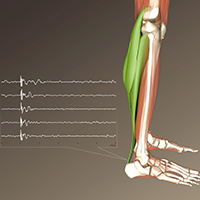Mechanotendography in Achillodynia shows reduced oscillation variability of pre-loaded Achilles tendon: a pilot study

Accepted: 9 April 2020
HTML: 29
All claims expressed in this article are solely those of the authors and do not necessarily represent those of their affiliated organizations, or those of the publisher, the editors and the reviewers. Any product that may be evaluated in this article or claim that may be made by its manufacturer is not guaranteed or endorsed by the publisher.
Authors
The present study focuses on an innovative approach in measuring the mechanical oscillations of pre-loaded Achilles tendon by using Mechanotendography (MTG) during application of a short yet powerful mechanical pressure impact. This was applied on the forefoot from the plantar side in direction of dorsiflexion, while the subject stood on the ball of the forefoot on one leg. Participants with Achilles tendinopathy (AT; n = 10) were compared to healthy controls (Con; n = 10). Five trials were performed on each side of the body. For evaluation, two intervals after the impulse began (0-100ms; 30-100ms) were cut from the MTG and pressure raw signals. The intrapersonal variability between the five trials in both intervals were evaluated using the arithmetic mean and coefficient of variation of the mean correlation (Spearman rank correlation) and the normalized averaged mean distances, respectively. The AT-group showed a significantly reduced variability in MTG compared to the Con-group (from p = 0.006 to p = 0.028 for different parameters). The 95% confidence intervals (CI) of MTG results were disjoint, whereas the 95% CIs of the pressure signals were similar (p = 0.192 to p = 0.601). We suggest from this work that the variability of mechanical tendon oscillations could be an indicative parameter of an altered Achilles tendon functionality.
How to Cite
PAGEPress has chosen to apply the Creative Commons Attribution NonCommercial 4.0 International License (CC BY-NC 4.0) to all manuscripts to be published.

 https://doi.org/10.4081/ejtm.2020.8983
https://doi.org/10.4081/ejtm.2020.8983




